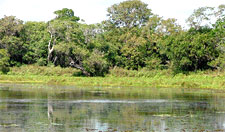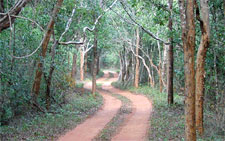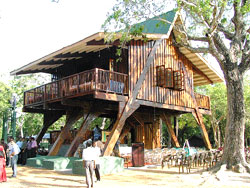Magnificent Wilpattu - Island
20-Feb-2004
 by Dasun
Edirisinghe
by Dasun
Edirisinghe
A popular belief among lovers of nature is that any time of the day
one can be sure of seeing a leopard at the Wilpattu National Park. This is not
just a saying, it is a fact and the Wilpattu National Park in Sri Lanka is among
the top national parks in the world. Both facts were amply evident when I
visited Wilpattu recently on a tour I am likely never to forget.
Ancient history...
The Wilpattu National Park and its surrounding are steeped in
history and covered with legend. Popular legend says that in 543 BC King Vijaya
landed at Kudrimalai and that he married Kuweni. According to some ancient ruins
identified, it is said that Kuweni lived in the place now identified as the Kali
Villu. Both Kudrimalai and Kali Villu are found in the Wilpattu. Furthermore
history shows that Prince Saliya, son of King Dutugemunu, lived with Asokamala
in Maradanmaduwa in Wilpattu over 2000 years ago. Pomparippu too is of
historical value as urns containing the remains of those belonging to pre
Vijayan times have been excavated from that site. Also between Palangaturai and
Kollankanatte are the remains of an old harbour.
The Park...
 In 1905, the designated area
in Wilpattu was declared a sanctuary. Thereafter it was upgraded to national
park status on February 25, 1938. However, the Wilpattu National Park was closed
to visitors from December 1988 due to the prevailing situation in the country
and the unstable security conditions in that area.
In 1905, the designated area
in Wilpattu was declared a sanctuary. Thereafter it was upgraded to national
park status on February 25, 1938. However, the Wilpattu National Park was closed
to visitors from December 1988 due to the prevailing situation in the country
and the unstable security conditions in that area.
After a sixteen year hibernation, it was reopened to visitors on
March 16, 2003, much to the relief of many nature lovers who had missed out on
the natural treasures of Wilpattu during its closure.
The location...
 The
park is located 30km west of Anuradhapura and spans the border between the North
Central and North Western Province. It is bordered by the Modaragam aru in the
south the Kala Oya in the north and is bordered by the Indian ocean in the west.
The Wilpattu National Park is the largest national park in the area with an
acreage of 131, 693 hectares. It is situated ranging from sea level to 152
metres above it.
The
park is located 30km west of Anuradhapura and spans the border between the North
Central and North Western Province. It is bordered by the Modaragam aru in the
south the Kala Oya in the north and is bordered by the Indian ocean in the west.
The Wilpattu National Park is the largest national park in the area with an
acreage of 131, 693 hectares. It is situated ranging from sea level to 152
metres above it.
The climate...
Annual temperature in the Park is around 27.2 Celsius and its
annual rainfall is approximately 1000 mm. Though situated in the dry zone, the
climate inside the Wilpattu National Park is very unlike that of the dry zone.
Upon entering the densely wooded Park, a feeling of going to a forest with
abundant water is what enters the mind. This is perhaps explained by the
patterns of rainfall it experiences. The period between September to December is
known as the rainy season at Wilpattu with the north eastern monsoon falling
heavily. Inter monsoon rains come to Wilpattu between March and April. The
period of drought extends from May to early September.
Its flora...
There are many Villu and lakes at Wilpattu. This is identified
as the main topographical feature of the Park. They are often flat and basin
like while containing purely rain water.
The western sector of Wilpattu is covered deeply with forests.
Many species of flora can be identified at Wilpattu national park. There are
three types of vegetation; Littoral vegetation, including Salt grass and low
scrub immediately adjacent to the beach and further inland, monsoon forest with
tall emergents, such as Palu (Manilkara hexandra), and Satin (Chloroxylon
swietenia), Milla (Vitex altissima), Weera (Drypetes sepiaria),
Ebony (Disopyros ebenum) and Wewarna ( Alseodaphne semecapriflolia).
The fauna...
Looking at the fauna of this national park mammalian diversity
and ecological densities are highest. A total of 31 species of mammals have been
identified at the Wilpattu national park. Mammals threatened with extinction are
also there. The elephant (Elephas maximus), Sloth bear (Melursus
ursinus), leopard (Panthera pardus kotiya) and water Buffalo (Bubalus
bubalis) are identified as the threatened species living within the Wilpattu
National Park.
We witness many kinds of birds flying about at the Wilpattu. The
Villus support both resident and migratory water fowl, including large breeding
populations of the Painted stork (Mycteria leucocephala) and Open billed stork (
Anastomus oscitans).
Other wetland bird species as Garganey (Anas querquedula), Pin
tail (Anas acuta), Whistling teal (Dendrocygna javanica), Spoonbill (Platalea
leucorodia), White ibis (Threskiornis malanocephalus), Large white egret
(Egretta alba modesta), Cattle egret (Bubulcus ibis) and Purple heron (Ardea
purpurea) also found at the Wilpattu National Park.
At Wilpattu, among the reptiles found the most common are the
Monitor (Varanus bengalensis), Mugger crocodile (Crocodylus palustris), Common
cobra (Naja naja), Rat snake (Ptyas mucosus), Indian python (Python molurus),
Pond turtle (Melanonchelys trijuga) and the Soft shelled turtle (Lissemys
punctata) who are resident in the large permanent Villus. We can saw Star
tortoises (Geochelone elegans) roaming on the grasslands at Wilpattu. Termites
of the Genus Trinervitermes clan probably account for the most significant
proportion of the invertebrate bio mass. Termites are found not on the
grasslands but actively living in the scrub forests.
Nearly sixty lakes and tanks are found spread around the
Wilpattu National Park.
Also there are seven circuit bungalows at Wilpattu national park
situated Maradanmaduwa, Pannikar Villu, Kalli Villu, Mena Villu, Thala Villu,
Manikkapola Uttu and Kokmottai. Six of them are still not habitable due to
various conditions prevailing in those areas. The Kokmottai circuit bungalow is
now habitable after extensive renovations.
A looming threat...
Wilpattu national park is the oldest and perhaps the most
important protected area in Sri Lanka. Itís fauna and flora are representative
of the dry lowland zone. It is unfortunate that many species living in the park
are threatened species.
Furthermore the affects of hunters and biodiversity smugglers
are threatening the natural balance of the Park. Only recently, the Mayor of
Beruwala Mashahim Mohamed was caught by Wild Life Department Officers while he
was trying to smuggle 12 Open Billed storks illegally. The is something that
needs to be stopped quickly if we are to safeguard Wilpattu and its delicate
natural balance.
 by Dasun
Edirisinghe
by Dasun
Edirisinghe In 1905, the designated area
in Wilpattu was declared a sanctuary. Thereafter it was upgraded to national
park status on February 25, 1938. However, the Wilpattu National Park was closed
to visitors from December 1988 due to the prevailing situation in the country
and the unstable security conditions in that area.
In 1905, the designated area
in Wilpattu was declared a sanctuary. Thereafter it was upgraded to national
park status on February 25, 1938. However, the Wilpattu National Park was closed
to visitors from December 1988 due to the prevailing situation in the country
and the unstable security conditions in that area. The
park is located 30km west of Anuradhapura and spans the border between the North
Central and North Western Province. It is bordered by the Modaragam aru in the
south the Kala Oya in the north and is bordered by the Indian ocean in the west.
The Wilpattu National Park is the largest national park in the area with an
acreage of 131, 693 hectares. It is situated ranging from sea level to 152
metres above it.
The
park is located 30km west of Anuradhapura and spans the border between the North
Central and North Western Province. It is bordered by the Modaragam aru in the
south the Kala Oya in the north and is bordered by the Indian ocean in the west.
The Wilpattu National Park is the largest national park in the area with an
acreage of 131, 693 hectares. It is situated ranging from sea level to 152
metres above it.